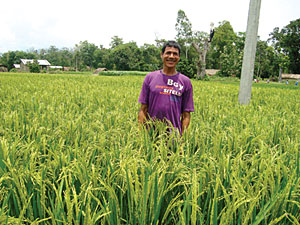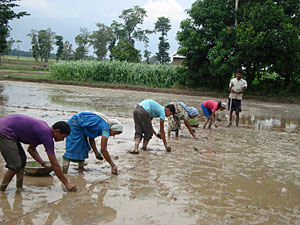 PICS: RUBEENA MAHATO HAPPY FARMERS: Lalku Katharia proudly shows the bumper harvest of rice in his farm. |
It sounds too good to be true. Lalku Katharia, a farmer in Lalbojhi of Kailali has doubled his rice harvest from half the seeds he used last year. He did this without even needing to flood his fields with scarce irrigation water.
Lalku and other farmers in western Nepal are taking part in trials of a new technique called SRI (System of Rice Intensification) which have been shown to increase rice production by more than double with fewer seeds and fertilisers, even in arid areas. It seems to be ideal solution to a food-deficit country dependent on rain-fed agriculture.
"Look, I didn't have to flood my field, and there are 100 tillers from a single seedling," says Lalku, showing us his rice patch, "earlier I used to get only 10 tillers each." SRI also produces sturdier plants with thicker tufts that can withstand floods.
 Bedanand Upadhay shows a rice seeding he is ready to transplant. |
Some government officials and the UN's Food and Agriculture Organisation are enthusiastic with the trials and say SRI could hold answer to Nepal's food insecurity. A timely monsoon and the winter rains boosted harvests, and Nepal recorded a grain surplus of 111,000 tons this year. However, 38 districts still face food shortages and 41 per cent of the country's population is undernourished. The country needs to feed more with less and SRI seems to be one answer.
"If SRI is adopted in a national scale, we can double our rice production with ten per cent the seeds, half the fertilisers and very little water. What could be more perfect?" asks Rajendra Uprety, a government agriculture officer who helped introduced the technique in Nepal (see box). In Morang, 2,000 farmers are regularly using SRI and are happy
with it.
Lalku is now getting his second harvest from SRI just before the monsoon floods can damage crops. Crops in this part of Kailali are prone to annual floods from the Mohana river, and has not seen a good harvest in five years. SRI is perfect for these places as it does not require much water and rice can be planted early on in the dry months when flooding is not a problem .
 |
In Dakshin Purba VDC, 24 farmers this year converted to SRI with assistance from FAO. Farmers are trained in the technique right from the transplanting to harvest in field schools over a period of 16 weeks.
"Where irrigation is available, SRI can be done pre-moonson, allowing farmers to harvest at least one rice crop before the rains, increasing their food security," explains Xavier Bouan of FAO.
However, while farmers across the Tarai don't need much convincing about SRI, the government in Kathmandu is more reluctant. The National Agriculture Research Council (NARC) is still not backing SRI as government policy. "It is surprising why the government is not supporting SRI," says Bijay Mallik, Director General of Department of Agriculture. "But we are not waiting for NARC and are holding SRI demonstrations in all rice growing districts so that farmers can adopt the technique themselves."
How it works
 |
With all the advantages it offers, SRI is quite simple, and can be done on local or hybrid varieties alike. Instead of waiting for the seedlings to mature, young plants of 8-10 days are transplanted one by one, allowing the roots to spread out further. They are also planted farther apart, at 20 cms, so that seeds don't have to compete for food and light and this also reduces the amount of seed required. The difference of old rice and new rice transplanted at the same time is apparent in paddy fields of Dakhsin Purwa VDC, Kailali (pictured, right). The patch in the foreground uses the old method, and the one behind uses the System of Rice Intensification (SRI).
The field is irrigated just enough, without submerging it in water and water is drained two-three times at an interval of 15 days. This allows bacteria in the soil to improve fertility. A weeder machine and composting means less pesticides and fertilizers are needed.
Traditional paddy-growing submerges fields to control weeds and pests, and the downside of SRI is that it is more labour intensive, requiring more hands for weeding, timely drainage and careful planting. But the benefits in greater harvests far outweigh these shortcomings. SRI produces 150 quintals of rice per hectare for a land that yielded 20 to 30 quintals in the old method, using 35 per cent less water, 10 per cent of seed and 50 per cent less fertilisers.
SRI in Nepal
 |
In Nepal, SRI was pioneered by Rajendra Uprety (pictured) when he was District Agriculture Extension Officer in Morang. He read about it in an agriculture journal and decided to give it a try. Today there are SRI tests and demonstrations being carried out in 35 districts across the country: 300 ha in Dang, 120 ha in Jhapa and 80 ha in Kailali. Test plots like these produce up to 12 tons per hectare, compared to 3 to 5 tons produced by the old method.
Read also
Nepal can feed itself, HEADLINE
See also:
The miracle is it's no miracle, KUNDA DIXIT
Growing much more rice, RAJENDRA UPRETY in MORANG
Less food, more mouths to feed, KUNDA DIXIT


